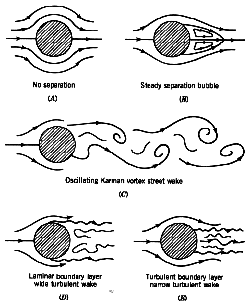Quote:
Originally Posted by CigaR007

I was reading on MAF sensors ( Mass flow sensor - Wikipedia, the free encyclopedia) and found this gif animation to be quite interesting.

So I tried to re-create it using using Flow Illustrator. Here's what I obtained.
From the looks of it, you can see that the "wake" pattern seems to be the same. Pretty sure that it can be even closer with some further tweaking of the velocity and viscosity.
So, it is possible to simulate with a certain precision, but as stated previously, it requires you to know what the flow should look like. Quite an interesting result nonetheless ! |
CigaR007, seeing expect Karmen vortex street from a cylinder is good progress - thanks. This is one of several characteristic patterns.
Drag of Blunt Bodies and Streamlined Bodies

"Figure 3. Flow patterns for flow over a cylinder: (A) Reynolds number = 0.2; (B) 12; (C) 120; (D) 30,000; (E) 500,000. Patterns correspond to the points marked on figure 2."
If I wasn't hamstrung by LoFi now I'd love to pick up here in two ways. (On dialup downloading anything is painful especially with spotty service - sigh).
First, play with higher and lower Re values. See if regime change as a function of Re can be established. End result would be a table of fudge factors for this particular geometry.
Second, using one set of parameters (ie, velocity 365, viscosity 165) play with cylinder size relative to simulation window. Try half and double for example. See if scale effects flow pattern. If so, does direction of correlation jive with relative Re effect.
The overall idea being to find a sweet spot window of utility for our potential purposes.

Rock on!